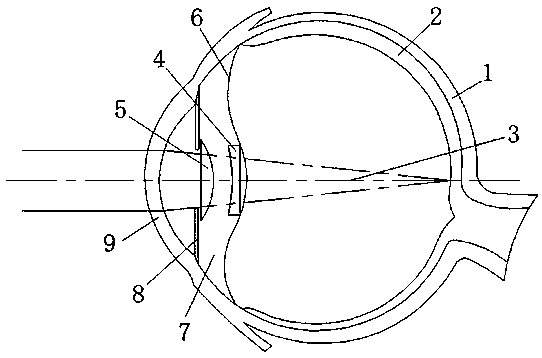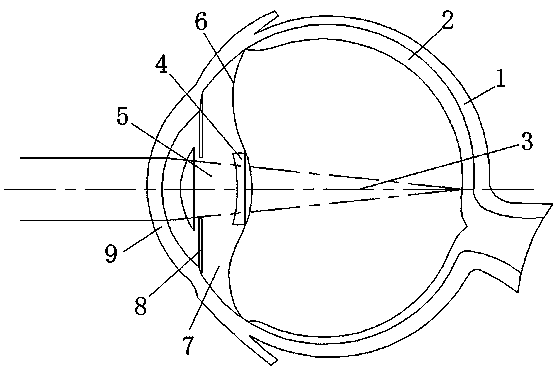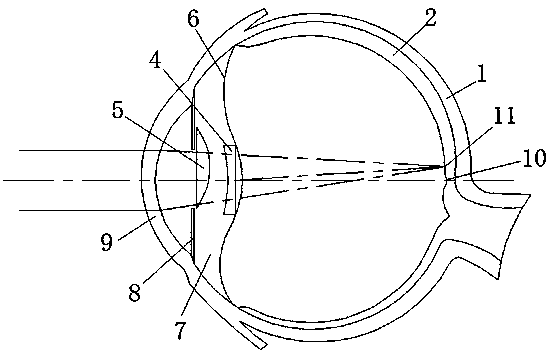Novel intraocular lens system
An intraocular lens and lens technology, applied in the direction of intraocular lens, eye implant, etc., can solve the problems of not considering the offset of imaging optical axis and adjustment structure, poor adjustment effect, severe degree of corneal astigmatism, etc.
- Summary
- Abstract
- Description
- Claims
- Application Information
AI Technical Summary
Problems solved by technology
Method used
Image
Examples
Embodiment 1
[0026] Example 1, see figure 1 , the present invention provides a technical solution: a novel intraocular lens system, comprising a rear group lens 4 and a front group lens 5, the rear group lens 4 and the front group lens 5 are all located in the posterior chamber structure 7 of the eyeball 1, the The rear group of lenses 4 includes at least one first lens, and the rear group of lenses 4 is close to the front of the posterior capsule 6 inside the eyeball 1, and the front group of lenses 5 also includes at least one second lens, and the front group of lenses 5 also includes at least one second lens. The lens 5 is arranged between the posterior capsule 6 and the iris 8 of the eyeball 1, the front group lens 5 and the rear group lens 4 form a rotationally symmetrical imaging system around the optical axis 3 of the eyeball 1, and the front group lens 5 and the The combined optical properties of the rear group lens 4 can provide a suitable magnification, and the relationship betwe...
Embodiment 2
[0032] Example 2, see figure 2 , the present invention provides a technical solution: a novel intraocular lens system, comprising a rear group lens 4 and a front group lens 5, the rear group lens 4 includes at least one first lens, and the rear group lens 4 is close to The front of the posterior capsule 6 inside the eyeball 1, the front group lens 5 also includes at least one second lens, and the front group lens 5 is arranged between the iris 8 of the eyeball 1 and the cornea 9 of the eyeball 1, the The front group lens 5 and the rear group lens 4 form a rotationally symmetrical imaging system around the optical axis 3 of the eyeball 1. This imaging system can provide a corresponding magnification according to different patients, and is suitable for patients with macular deformation or other eye diseases. The low-density light-sensitive fundus, the additional preferred structure has better aberration tolerance, and the accuracy of the implantation position is lower.
[0033...
Embodiment 3
[0040] Example 3, see image 3 , and the difference from Embodiment 1 is that the front group lens 5 of the cornea 9 and the intraocular lens system are formed through the intentional decentering (the optical element is on a plane perpendicular to the optical axis and deviates from the coaxial position) the front group lens 5 The anterior segment imaging system constituted together with the rear lens group 4 will transmit the clearest image to the paracentral area 11 deviated from the fovea area 10 of the macula;
PUM
 Login to View More
Login to View More Abstract
Description
Claims
Application Information
 Login to View More
Login to View More - R&D
- Intellectual Property
- Life Sciences
- Materials
- Tech Scout
- Unparalleled Data Quality
- Higher Quality Content
- 60% Fewer Hallucinations
Browse by: Latest US Patents, China's latest patents, Technical Efficacy Thesaurus, Application Domain, Technology Topic, Popular Technical Reports.
© 2025 PatSnap. All rights reserved.Legal|Privacy policy|Modern Slavery Act Transparency Statement|Sitemap|About US| Contact US: help@patsnap.com



